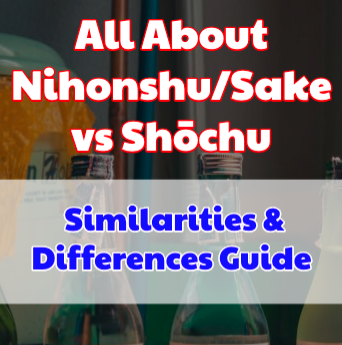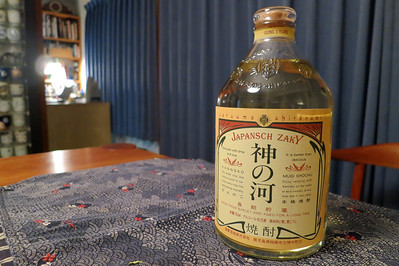Sake and Shochu.
These are the 2 main types of Japanese alcohol. But, what’s difference between Sake vs Shochu?

Well, you landed on the right site: ItsJapanese.com! Before we get into the differences…
- In Part 1, you’ll get the basic gist of what Sake/Nihonshu is
- In Part 2, you’ll get the basics on Shochu
Just so you know the background info about Sake vs Shochu. And then…
- In Part 3, you’ll learn the similarities and differences
Cool? Cool.
All About Nihonshu/Sake
First, let’s clear things up:
Sake is the general word for alcohol in Japan. And Nihonshu is what Sake is called in Japan. So, Nihonshu and Sake are the same thing. The terms are used interchangeably.
Okay… now onto Sake.
Although Sake is slowly becoming popular in Western societies, in Japan, Sake is not just an alcoholic beverage. Sake is also an important part of in Japanese culture. The consumption of Sake is usually done with an intentional purpose. One intention would be as an offering to God. Especially within Shintoism, followers of this religion would make offerings to God on designated days. Closely tied to this, is the intention of celebration. On special occasions such as weddings, New Years, or celebrations of longevity, Sake will always be a necessity!
There is also an entire ranking system categorizing different types of Sake. Evidence as to how seriously the Japanese take their Sake! This ranking system divides Sake into 8 tiers, and for simplification purposes, we can refer to the first 4 tiers as one category, and the next 4 tiers as another. Here is the ranking system:
| Name | Ingredient | Rice Polishing Ratio |
| Junmai Daiginjo /
純米大吟醸 |
Rice, Malted rice | < 50% |
| Junmai Ginjo /
純米吟醸 |
Rice, Malted rice | < 60% |
| Tokubetsu Junmai /
特別純米 |
Rice, Malted rice | < 60% or others |
| Junmai shu /
純米酒 |
Rice, Malted rice | No regulation |
| Daiginjo /
大吟醸 |
Rice, Malted rice, brewer’s alcohol. | < 50% |
| Ginjo /
吟醸 |
Rice , Malted rice, brewer’s alcohol. | < 60 % |
| Tokubetsu Honjozo /
特別本醸造 |
Rice, Malted rice, brewer’s alcohol. | < 60% or others |
| Honjozo /
本醸造 |
Rice , Malted rice, brewer’s alcohol. | < 70% |
The first category, “Junmaishu”, is made solely from Rice, Malted Rice, and Water. Its’ ranking depends on the Rice Polishing Ratio (RPR). For example, “Junmai Daiginjo” has a RPR of less than 50%, meaning less than 50% of the original rice grain has been used for brewing. This differs from “Junmai Ginjo”, where less than 60% of the original rice grain has been used for brewing. The lower the RPR, the more fragrant the rice grain will be. This is because more of the outer layers of the rice grain have been removed, leaving the innermost layer of concentrated starch to be brewed.
The second category, “Ginjoshu” and “Jozoshu”, is made from Rice, Malted Rice, and an addition of a brewer’s alcohol. Once again, its’ ranking depends on the RPR. Essentially, the more concentrated the rice grain – i.e. the lower the percentage of RPR, the higher the quality of the Sake.
Despite these rankings, it is not necessarily the case that the higher ranking Sakes are ‘better’. Although the lower RPR Sakes are said to be sweeter and more aromatic, it still does depend on individual preference!
Now, let’s move onto Shochu.
All About Shochu
In the Japanese language, the word “Sho” (焼 ・しょう) means “adding heat’, and “Chu” (酎・ちゅう) means “strong alcohol. Literally translating the word Shochu to “distilled strong alcohol”.
Historical documents suggest that the distillation technique to produce Shochu was imported into and adopted by Japan around the 16th century. It is believed that it was first imported from the Southeast Asian regions, and those from Thailand started their production in the Okinawa and Kyushu Area.
In Okinawa, they began producing Shochu that was called “Awamori” (泡盛・あわもり), a type of Shochu made from Thai rice. In Kyushu, they used a variety of vegetables, including: Sweet Potato to produce “Imo Shochu” (芋焼酎・いもしょうちゅう), Barley to produce “Muji Shochu” (麦焼酎・むぎしょうちゅう), Buckwheat to produce “Soba Shochu”(蕎麦焼酎・そばしょうちゅう), and Brown Sugar to produce “Kokuto Shochu”(黒糖焼酎・こくとうしょうちゅう).
There are a total of 854 Shochu production facilities in Japan, of which 382 are based in Kyushu. The warm climate and abundance of crops makes Kyushu the optimal area for Shochu production, explaining why 45% of total production is carried out there! Alongside its abundance in production, a study found that they are highly ranked in consumption as well! This study ranked the average Shochu consumption per adult according to prefectures in Japan. The top 5 prefectures – i.e. the top 5 highest consumption rates per adult, were in Kyushu. It seems like the people in Kyushu enjoy having Shochu produced in their region!
Sake vs Shochu: Similarities & Differences
A) Similarities:
One similarity between Nihonshu/Sake vs Shochu would be their clear and transparent appearance. This transparent form is usually how people would consume them; however, both Nihonshu and Shochu have their variants. Nihonshu can be a thick white color if you choose to enjoy this beverage before it has been filtered, or before complete filtration. Shochu can turn into an amber color, similar to that of whiskey, when left in a certain environment!
B) Differences between Nihonshu vs Shochu:
Aside from the ingredients and production methods – i.e. brewing vs distilled, they also differ in:
1.ALCOHOL CONTENT
Nihonshu’s alcoholic content is 15-16%, while Shochu generally contains 20-25% alcohol.
2.TASTE
The taste of Sake is heavily dependent on the quality of rice used as well as the added brewer’s alcohol. In general, the taste of “Junmaishu” is sweet, mild, and rich in fragrance, while the taste of “Ginjoshu” and “Jozoshu” is clear and dry. Similarly, Shochu is described as clear and dry. The taste and fragrance of Shochu depends on the ingredients used – i.e. Barley, Buckwheat, etc.
3.METHOD OF CUMSUMPTION
Nihonshu is typically consumed ‘straight’ at room temperature, warmer temperatures, and even cold temperatures. However, it will almost always be consumed without any added components. Since Shochu has a much higher alcohol content, it is usually consumed in one of the following ways: ‘on the rocks’ – i.e. with ice cubes, mixed with water – i.e. Mizuwari ( 水割り・みずわり), mixed with hot water – i.e. Oyuwari (お湯割り・おゆわり ), or mixed with other carbonated drinks – i.e. Chuhai (酎ハイ・ちゅうはい ).
- SUGAR CONTENT
Nihonshu has a sugar content of 3.6g per 100ml. Interestingly, Shochu has 0g of sugar – a fun fact for individuals on a diet, as they can enjoy drinking Shochu without worrying about the calories!
Conclusion
Now you know a bit about Sake vs Shochu and what makes them different.
Are there other differences or similarities that I might have missed?
Leave a comment!
If you’re interested in learning more about Japanese food, here are some relevant articles:
Thanks for reading (and eating)!
Team IJ



